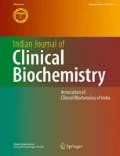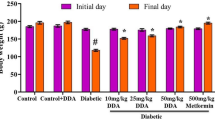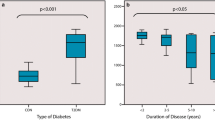Abstract
The study was undertaken to evaluate the therapeutic effect of mustard oil incorporated diet in streptozotocin (STZ)-induced type 1 diabetic rats. Dietary composition has shown to play a significant role in improving insulin sensitivity. Various authors have reported the hypoglycemic effect of mustard oil in experimentally induced diabetic rats. In the present study, reverse transcriptase polymerase chain reaction (RT-PCR) was done to analyze the Glut 4 expression in STZ induced diabetic rats as it is a key player in glucose homeostasis. The effect of mustard oil on serum biochemical parameter and insulin levels was also studied. Twenty-four male Wistar rats were randomly divided into three different groups with each containing eight animals. The first, second and third groups were control, diabetic control and treatment group with mustard oil respectively. All the rats in respective groups were fed for 60 days with iso-caloric mash diet containing 8% lipid. Diabetes was induced by intra-peritoneal administration of STZ (40 mg/kg body weight). A highly significant reduction in blood glucose level, with an increase in insulin activity was observed in mustard oil-treated diabetic rats when compared to control group indicating anti-hyperglycemic activity of mustard oil. Mustard oil-treated diabetic rats showed increased expression of Glut 4 in muscle tissue when compared to diabetic control. A significant reduction in the levels of triacylglycerols, total cholesterol, VLDL and LDL and raised plasma HDL were noticed in mustard oil-treated diabetic rats when compared to diabetic control rats. Histopathological studies revealed a mild regeneration of β cells of pancreas in mustard oil-treated diabetic rats. The results from our investigation suggest that mustard oil elicits hypoglycemic effect by increased insulin activity and up-regulation of Glut 4 gene expression in muscle tissue of STZ-induced diabetic rats.


Similar content being viewed by others
References
Hu FB. Globalization of diabetes: the role of diet, lifestyle and genes. Diabetes Care. 2011;346:1249–57.
Pandey A, Tripathi P, Pandey R, Srivatava R, Goswami S. Alternative therapies useful in the management of diabetes: a systematic review. J Pharm Bioallied Sci. 2011;3(4):504–12.
Riserus U, Willett WC, Hu FB. Dietary fats and prevention of type 2 diabetes. Prog Lipid Res. 2009;48(1):44–51.
Schmincke KH. Medicinal plants for forest conservation and healthcare. Non-Wood Forest Products, vol. 11, Food and Agriculture Organization of the United Nation; 2003. http://www.fao.org/3/a-w7261e.pdf. Accessed 28 Dec 2014.
Patil V, Baghel MS, Thakar AB. Effect of snehapana (internal oleation) on lipids: a critical review. Anc Sci Life. 2009;29(2):32–9.
Dinesh Kumar B, Mukherjee S, Pradhan R, Mitra A, Chakraborty C. Effects of edible oils in type 2 diabetes mellitus. J Clin Diagn Res. 2009;3:1389–94.
Heshmati J, Namazi N, Memarzadeh M-R, Taghizadeh M, Kolahdooz F. Nigella sativa oil affects glucose metabolism and lipid concentrations in patients with type 2 diabetes: a randomized, double blinded, placebo-controlled trial. Food Res Int. 2015;70:87–93.
Soriguer F, Rojo-Martínez G, Goday A, Bosch-Comas A, Bordiú E, Caballero-Díaz F, Calle-Pascual A, Carmena R, Casamitjana R, Castaño L, Castell C, Catalá M, Delgado E, Franch J, Gaztambide S, Girbés J, Gomis R, Gutiérrez G, López-Alba A, Teresa Martínez-Larrad M, Menéndez E, Mora-Peces I, Ortega E, Pascual-Manich G, Serrano-Rios M, Urrutia I, Valdés S, Antonio Vázquez J, Vendrell J. Olive oil has a beneficial effect on impaired glucose regulation and other cardio metabolic risk factors. Eur J Clin Nutr. 2013;67(9):911–6.
Khan BA, Abraham A, Leelamma S. Hypoglycemic action of Murraya koenigii (curry leaf) and Brassica juncea (mustard): mechanism of action. Indian J Biochem Biophys. 1995;32(2):106–8.
Alam F, Islam A, Ibrahim Khalil M, Hua Gan S. Metabolic control of type 2 diabetes by targeting the GLUT4 glucose transporter: intervention approaches. Curr Pharm Des. 2016;22:3034–49.
Matsuzaka T, Shimano H. GLUT12: a second insulin-responsive glucose transporters as an emerging target for type 2 diabetes. J Diabetes Investig. 2012;3(2):130–1.
Barros RP, Machado UF, Warner M, Gustafsson JA. Muscle GLUT4 regulation by estrogen receptors ER beta and ER alpha. Proc Natl Acad Sci. 2006;103(5):1605–8.
Aggarwal BB, Sundaram C, Prasad S, Kannappan R. Tocotrienols, the vitamin E of the 21st century: its potential against cancer and other chronic diseases. Biochem Pharmacol. 2010;80:1613–31.
Marudamuthu AS, Leelavinothan P. Effect of pterostilbene on lipids and lipid profiles in streptozotocin–nicotinamide induced type 2 diabetes mellitus. J Appl Biomed. 2008;6:31–7.
Trinder P. In vitro enzymatic colorimetric method for the estimation of glucose in serum/plasma. Ann Clin Biochem. 1969;6:24–8.
Allain CC, Poon LS, Chan CG, Richard W, Fu PC. Enzymatic determination of total serum cholesterol. Clin Chem. 1974;20:470–5.
Foosati P, Prencipe L. Serum triglycerides determined colorimetrically with an enzyme that produces hydrogen peroxide. Clin Chem. 1982;28(10):2077–80.
Williams P, Robinson D, Bailey A. High density lipoprotein and coronary risk factor. Lancet. 1979;1:72.
Folch J, Lees M, Sloane-Stanley GH. A simple method for the isolation and of total lipides from animal tissues purification. J Biol Chem. 1957;226(1):497–509.
Marquard J, Otter S, Welters A, Strirban A, Fischer A, Eglinger J, et al. Characterization of pancreatic NMDA receptors as possible drug targets for diabetes treatment. Nat Med. 2010;21:363–72.
Ming Z, Xiao-Yan L, Jing L, Zhi-Gang X, Li C, “The characterization of high-fat diet and multiple low-dose streptozotocin induced type 2 diabetes rat model. Exp Diabetes Res. 2008. https://doi.org/10.1155/2008/704045.
Guyton AC, Hall JE. Textbook of medical physiology. 10th ed. Philadelphia: Saunders WB; 2000.
Kitukale MD, Chandewar AV. An overview on some recent herbs having antidiabetic potential. Res J Pharm Biol Chem Sci. 2014;5(6):190.
Murray RR, Granner DK, Mayes PA, Rodwell BW. Harper’s biochemistry. 25th ed. Stamford: Appleton and Lange; 1999.
Campbell PJ, Carlson MG, Hill JO, Nurjhan N. Regulation of free fatty acid metabolism by insulin in humans: role of lipolysis and reesterification. Am J Physiol. 1992;263(6):E1063–9.
Kumar Manoj, Kumar Suresh, Sharma Sunil, Vasudeva Neeru. In vivo assessment of antihyperglycemic and antihyperlipidemic potential of Sesamum indicum oil in streptozotocin induced diabetic rats. Diabetes Obes Int J. 2018;3(2):000176.
Davidson MB. Diabetes mellitus: diagnosis and treatment, vol. 1. New York: Wiley; 1981. p. 109.
Kumar V, Ahmed D, Gupta PS, Anwar F, Mujeeb M. Anti-diabetic, anti-oxidant and antihyperlipidemic activities of Melastoma malabathricum Linn leaves in streptozotocin induced diabetic rats. BMC Complement Altern Med. 2013;13(222):1–19.
Abbott SK, Else PL, Hulbert AJ. Membrane fatty acid composition of rat skeletal muscle is most responsive to the balance of dietary n − 3 and n − 6 PUFA. Br J Nutr. 2010;103:522–9.
Ginsberg BH, Brown TJ, Simon I, Spector AA. Effect of the membrane lipid environment on the properties of insulin receptors. Diabetes. 1981;30:773–80.
Storlien LH, Pan DA, Kriketos AD, Connor JO, Caterson ID, Cooney GJ, Jenkins AB, Blaur LA. Skeletal muscle membrane lipids and insulin resistance. Lipids. 1996;31:S261–5.
Chowdhury K, Banu LA, Khan S, Latif A. Studies on the fatty acid composition of edible oil. Bangladesh J Sci Ind Res. 2007;42(3):311–6.
Murali B, Upadhyaya UM, Goyal RK. Effect of chronic treatment with Enicostemma littorale in non-insulin-dependent diabetic (NIDDM) rats. J Ethnopharmacol. 2002;81:199-04.
Coderre L, Kandror KV, Vallega G, Pilch PF. Identification and characterization of an exercise-sensitive pool of glucose transporters in skeletal muscle. J Biol Chem. 1995;270:27584–8.
Klip A, Volchuk A, He L, Tsakiridis T. The glucose transporters of skeletal muscle. Sem Cell Dev Biol. 1996;7:229–37.
Kahn BB, Rosen AS, Bak JK, Andersen PH, Damsbo P, Lund S, et al. Expression of GLUT1 and GLUT4 glucose transporters in skeletal muscle of humans with insulin-dependent diabetes mellitus: regulatory effects of metabolic factors. J Clin Endocrinol Metab. 1992;74:1101–9.
Acknowledgements
We are greatly thankful to Tamil Nadu Veterinary and Animal Sciences University for providing financial support for conducting this study.
Author information
Authors and Affiliations
Corresponding author
Ethics declarations
Conflict of interest
On behalf of all authors, the corresponding author declares that there is no conflict of interest.
Ethical approval
On behalf of all authors, the corresponding author declares that all procedures performed in studies involving animals were in accordance with the ethical standards of the Institutional Animal Ethical Committee (IAEC), Madras Veterinary College, Chennai-600007 with IAEC approval number 1679/DFBS/B/2015. The animals were taken care according to the guidelines of Committee for the Purpose of Control and Supervision of Experiments on Animals (CPCSEA), Govt. of India.
Informed consent
On behalf of all authors, the corresponding author declares that no human subjects were included in this study hence the need does not arise.
Additional information
Publisher's Note
Springer Nature remains neutral with regard to jurisdictional claims in published maps and institutional affiliations.
Rights and permissions
About this article
Cite this article
Sukanya, V., Pandiyan, V., Vijayarani, K. et al. A Study on Insulin Levels and the Expression of Glut 4 in Streptozotocin (STZ) Induced Diabetic Rats Treated with Mustard Oil Diet. Ind J Clin Biochem 35, 488–496 (2020). https://doi.org/10.1007/s12291-019-00852-x
Received:
Accepted:
Published:
Issue Date:
DOI: https://doi.org/10.1007/s12291-019-00852-x




